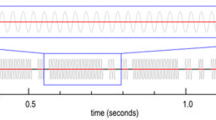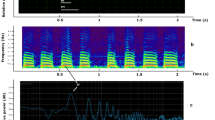Summary
-
1.
Crickets of the non-stridulating speciesPhaeophilacris spectrum (Phalangopsidae) generate travelling air vortex rings, which might serve as a hitherto unknown method of non-acoustic communication involving air particle movements.
-
2.
The males produce a series of forward wing flicks during courtship and single wing flicks during aggressive encounters (Figs. 1, 2). In simulation experiments with moving wing pairs (Fig. 3) travelling vortex rings were visualized by using TiCl4 smoke or tracer particles in the air flow field (Fig. 4).
-
3.
The vortex rings have an initial diameter of about 2 cm, increasing to 5 cm, and travel a maximum distance of 15 cm, depending on wing size and wing flick duration. Both wing size and flick duration determine the Reynolds number (Fig. 6).
-
4.
Generally the velocity of propagation of vortex rings (from an initial velocity of about 40 cm/s) decays exponentially with distance (Fig. 5B).
-
5.
The internal structure of the vortex rings, as visualized with tracer particles (Fig. 8), reveals a typical rotational velocity field. Particle velocities approach 15 cm/s (Fig. 9).
-
6.
The physical basis of vortex ring generation by wing flicks and their possible communication role are discussed.
Similar content being viewed by others
References
Alexander RD, Otte D (1967) The evolution of genitalia and mating behavior in crickets (Gryllidae) and other Orthoptera. Misc Publ Mus Zool Univ Mich No. 133
Bennet-Clark HC (1975) Acoustics and the behaviour ofDrosophilia. Verh Dtsch Zool Ges 1975:18–28
Boake CRB (1983) Mating systems and signals in crickets. In: Gwynne DT, Morris GK (eds) Orthopteran mating systems. Westview Press, Boulder, Colorado, pp 28–44
Dambach M, Lichtenstein L (1978) Zur Ethologie der afrikanischen GrillePhaeophilacris spectrum Saussure. Z Tierpsychol 46:14–29
Heidelbach J (1986) Untersuchungen zum Balzverhalten und zur kommunikativen Bedeutung von Luftwirbelreizen bei der GrillePhaeophilacris spectrum. Universität Köln, Diplomarbeit
Kämper G (1978) Untersuchungen zur Kinematik und den funktionsanatomischen Grundlagen zur Flügelschlagaktivität der GrillePhaeophilacris spectrum. Universität Köln, Diplomarbeit
Kämper G, Dambach M (1979) Communication by infrasound in a non-stridulating cricket. Naturwissenschaften 66:530
Kämper G, Dambach M (1985) Low-frequency airborne vibrations generated by crickets during singing and aggression. J Insect Physiol 31:925–929
Kaltenbach A (1983) Vorarbeiten für eine Revision der Phalangopsidae der äthiopischen Faunenregion (Saltatoria-Grylloidea). 2. Revision der ostafrikanischen und nordostafrikanischen Arten der GattungPhaeophilacris Walker. Sitzungsber Österr Akad Wiss 192:267–306
Kanou M, Shimozawa T (1984) A threshold analysis of cricket cereal interneurons by an alternating aircurrent stimulus. J Comp Physiol A 154:357–365
Kokshaysky NV (1979) Tracing the wake of a flying bird. Nature 279:146–148
Kutsch W (1969) Neuromuskuläre Aktivität bei verschiedenen Verhaltensweisen von drei Grillenarten. Z Vergl Physiol 63:335–378
Lugt HJ (1979) Wirbelströmung in Natur und Technik. G. Braun, Karlsruhe
Magarvey RH, MacLatchy CS (1964) The formation and structure of vortex rings. Can J Physics 42:678–683
Maxworthy T (1972) The structure and stability of vortex rings. J Fluid Mech 51:15–32
Maxworthy T (1977) Some experimental studies of vortex rings. J Fluid Mech 81:465–495
Maxworthy T (1979) Experiments on the Weis-Fogh mechanism of lift generation by insects in hovering flight. Part 1. Dynamics of the ‘fling’. J Fluid Mech 93:47–63
Merzkirch W (1974) Flow visualization. Academic Press, New York London
Nachtigall W (1967) Aerodynamische Messungen am Tragflügelsystem segelnder Schmetterlinge. J Comp Physiol 54:210–231
Nachtigall W (1979) Gleitflug des FlugbeutlersPetaurus breviceps papuanus (Thomas). III. Modellmessungen zum Einfluß des Fellbesatzes auf Umströmung und Luftkrafterzeugung. J Comp Physiol 133:339–349
Otte D (1977) Communication in Orthoptera. In: Sebeok TA (ed) How animals communicate. Indiana University Press, Bloomington, pp 334–361
Pierce D (1961) Photographic evidence of the formation and growth of vorticity behind plates accelerated from rest in still air. J Fluid Mech 11:460–471
Rayner JMV, Jones G, Thomas A (1986) Vortex flow visualizations reveal change in upstroke function with flight speed in bats. Nature 321:162–164
Siekmann J (1963) On a pulsating jet from the end of a tube, with application to the propulsion of certain aquatic animals. J Fluid Mech 15:399–418
Tautz J (1979) Reception of particle oscillation in a medium — an unorthodox sensory capacity. Naturwissenschaften 66:452–461
Author information
Authors and Affiliations
Rights and permissions
About this article
Cite this article
Heinzel, HG., Dambach, M. Travelling air vortex rings as potential communication signals in a cricket. J. Comp. Physiol. 160, 79–88 (1987). https://doi.org/10.1007/BF00613443
Accepted:
Issue Date:
DOI: https://doi.org/10.1007/BF00613443




